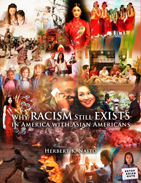
 |
Why Does Racism Still Exist in America with Asian Americans?
by Herbert K. Naito
Proisle Publishing Services
Author Naito propounds a significant view of racism, hate crimes, and discrimination at all levels as they manifest in America. He sets Hawaii as a positive exemplar for its statistically based multiculturism and proposes an effort, led by the University of Hawaii, to identify causes of, and solutions for, hate crime and racism wherever found. He devotes chapters to various immigrant groups in the US, beginning with the Chinese. Their arrival in the 1800s was based on economic factors. Those who came were hardworking men who were treated as slaves, engendering bias against them that still lingers. The Japanese migrated seeking better circumstances, with families settling, often as farmers, until World War II brought about their US internment in subhuman quarters. Still, these cultures, including Koreans who arrived later, maintain strong, respect-based standards for familial and social behaviors.
In his thought-proving book, Naito cites America’s prevalent concealed carry laws as a disturbing factor in hate crimes, urging readers to unite to ensure that children will be taught anti-racist, multicultural values and to publicly decry laws allowing readily available weaponry that has facilitated deadly race-based criminal activity. With multiple university degrees and honors, the author is an internationally respected speaker on the subjects addressed here. He writes with verve and sensitivity. In addition to helpful lists of active anti-racist organizations, Naito's text is arrayed with color photographs and offers pertinent statistics regarding the incidence of racial hatred in America and worldwide. He presents disturbing case studies of racial bullying among adults and youngsters and violence resulting from race hatred, along with the possibilities for combatting these trends for the guidance and benefit of all. Naito’s diligent research and revelations will likely provide a focus for workshops and hopeful innovations among a wide readership.